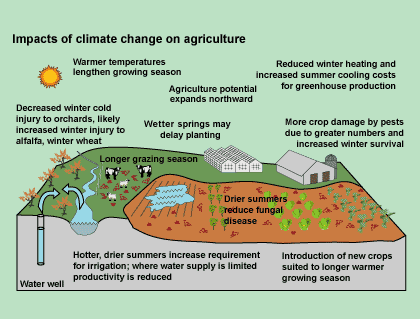| ||||||||||||||||||||||||||||
Proactive disclosure Print version |  Weathering the changes: Climate change in Ontario Our farms Agriculture is perhaps the sector where the effects of climate on productivity and operations are most obviously felt. Quite often we get seasons with too much or too little rain, too much or too little heat, a spring thaw that arrives too late or a frost that arrives too early. Warmer year-round temperatures and greater variability and predictability of precipitation, particularly in the winter months, will present farmers with new opportunities and new challenges. The opportunities
Warmer temperatures and earlier and longer frost-free periods (longer by as much as five weeks) will extend the grazing season and increase the potential yield of heat-loving crops such as corn, soybeans, and tomatoes. It is also possible that farmers may cultivate these crops farther north, depending on the suitability of the soil and the frequency and severity of drought. In southern Ontario, the potential for growing specialty fruits and vegetables may increase.  The challenges Less rainfall at different times could mean farmers would need more irrigation in southwestern Ontario, particularly on drought-prone soils and for shallow-rooted crops such as potatoes. Milder winters with less consistent snow cover are likely to lead to an increase in injury damage to over-wintering crops in some areas.
Did you know? References Smith, J.V., Lavender, B., Auld, H., Broadhurst, D., and Bullock, T., 1998: Adapting to climate variability and change in Ontario; in Volume IV of the Canada Country Study, Climate Impacts and Adaptation; Environment Canada, Ottawa, Ontario, 117 p.
|